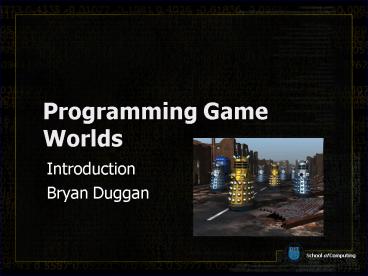Programming Game Worlds - PowerPoint PPT Presentation
1 / 19
Title:
Programming Game Worlds
Description:
Demonstrate an understanding of trends and advances in ... http://www.gamedevelopers.ie. General Gaming: http://www.pczone.co.uk. http://www.gamespot.com ... – PowerPoint PPT presentation
Number of Views:52
Avg rating:3.0/5.0
Title: Programming Game Worlds
1
Programming Game Worlds
- Introduction
- Bryan Duggan
2
Learning outcomes
- Demonstrate an understanding of trends and
advances in computer game technology. - Solve common problems in computer games such as
entity position, orientation and movement by
using a variety of mathematical tools. - Program a scene in 3D using standard APIs.
- Represent and program a flexible camera suitable
for a variety of game types (FPS and RTS). - Implement simple collision detection algorithms
and demonstrate an understanding of the issues
surrounding collision detection in commercial
games. - Use UML and object oriented design to model
computer games programs. - Program realistic entity movement by implementing
various individual and group steering behaviours. - Critically analyse how the techniques learned on
the course are used in commercial games.
3
You will like this course if
- You like programming in C
- You like using maths to solve problems
- You enjoy computer games and always wondered how
they work
4
You will not enjoy this course
- If you do not like programming in C!!!
- Because there is lots of programming
- Lots of self directed learning in the labs
5
Structure
- Lectures
- Monday 1600 1800
- Labs
- Thursday 1700-1800
- Friday 0900 1000
6
Course Overview
- Introduction to 3D games
- hardware
- APIs
- Game genres
- Maths refresher
- 3D Coordinate Geometry
- Trigonometry
- Vectors
- Matrices
7
Course Overview
- OO Refresher
- Procedural programming
- Classes objects
- Access
- Inheritance
- STL Vectors, Lists, Queues
8
Course Overview
- Introduction to Direct3D programming
- Anatomy of a game engine
- Creating an IDirect3DDevice COM object
- The IDirect3DDevice state machine
- Introduction the game engine
- Basic drawing
- The rendering pipeline
- Local space, world space, view space
- The camera and frustum
- Vertex formats
- Creation of vertex buffers index buffers
- Drawing primitives
9
Course Overview
- Basic drawing Part 2
- Colour
- Shading
- Intro to texturing
- Introduction to meshes
- Maybe terrain rendering particle systems
- Stuff we are leaving out
- Lighting
- Blending
- HLSL
- The effects framework
- Stencilling
10
Course Overview
- Building a flexible camera
- Using your knowledge of co-ordinate geometry,
matrices and 3D graphics - Building a movable game object
- Dalek and projectile
- Simple collision detection
- Point\Bounding sphere\bounding 3D box collisions
- Game asset management
- The Singleton pattern
11
Programming Game Behaviour (Semester 2)
- Introduction
- Bryan Duggan
12
Learning Outcomes
- Compare approaches to implementing perception and
propose optimised solutions to perception
problems. - Critically analyse how perception is implemented
in commercial computer games. - Implement a variety of path following and path
finding algorithms. - Demonstrate an understanding of the issues
involved in practical, optimised path finding. - Use UML and object orientated design to model
both technical architectures and behaviours in
computer games. - Propose architectures for NPC higher order
decision making. - Critically analyse how the techniques learned on
the course are used in commercial games.
13
Course Overview
- Graphs
- Navigation graphs, dependency graphs and state
graphs - Implementing a flexible graph class using C
templates - Automatic generation of navigation graphs
- Graph search algorithms
- Dijstras shortest path algorithm
- The A algorithm
- Advanced locomotion
- Neutons laws of force and acceleration
14
Course Overview
- Perception
- FOV
- Intersection of 2 lines
- Intersection of ray and plane
- Intersection of 2 planes
- Game AI using state machines
- The state machine design pattern
- State transition diagrams
- Agents?
- Modding?
15
Assessment
- 1 in class test/preliminary deliverable (mid
semester 1) 5 - Assignment 1 Due January 2005 10
- A partial game engine in C
- 3d engine for a RTS
- Something similar in semester 2
16
If you know all the above, you will have a good
grounding in how modern game engines are
constructed
17
Books
- Semester 1
- Introduction to 3D Game Programming with DirectX
9.0 - Frank D. Luna
- Semester 2
- Programming Game AI by Example
- Mat Buckland
18
Tools
- Microsoft Visual C (Anything from version 6.0
or above with the latest service packs will do
fine) - Latest DirectX 9 SDK
19
Web Resources
- Course Notes
- http//webcourses.dit.ie
- Games Developers
- http//www.gameasutra.com/
- http//www.gamedevelopers.ie
- General Gaming
- http//www.pczone.co.uk
- http//www.gamespot.com































